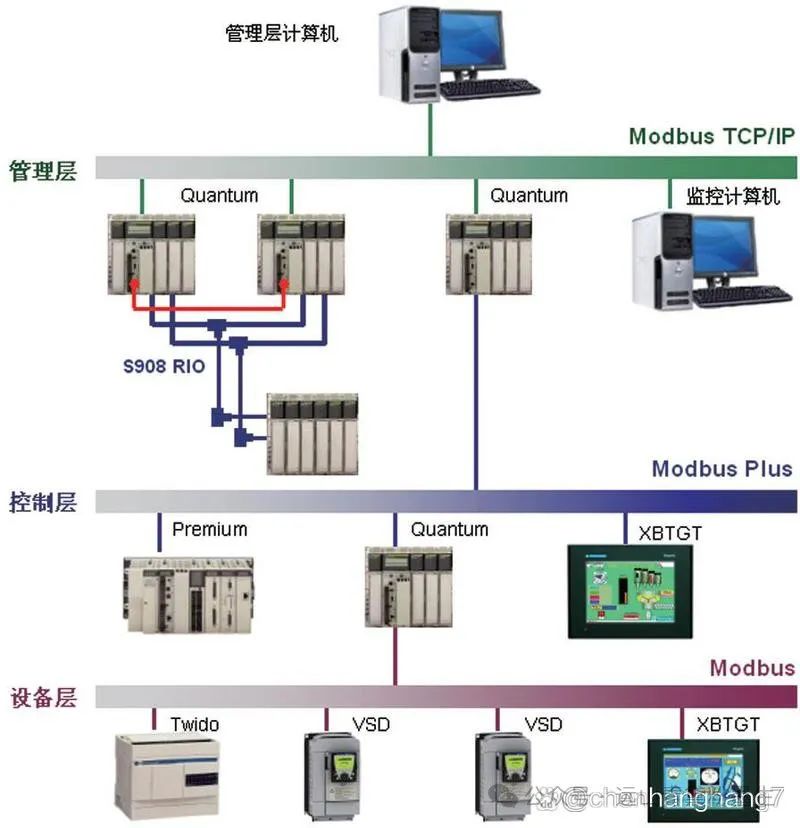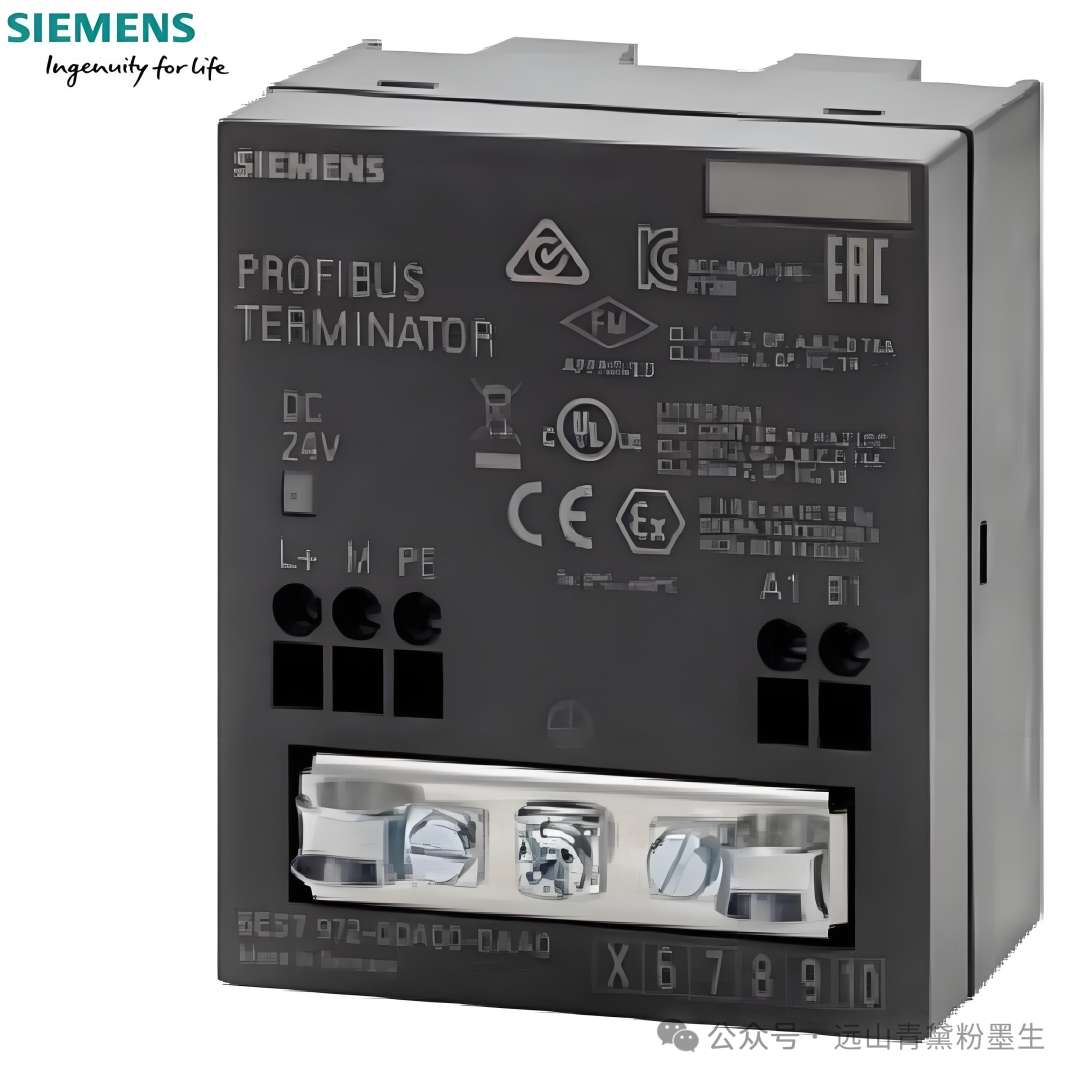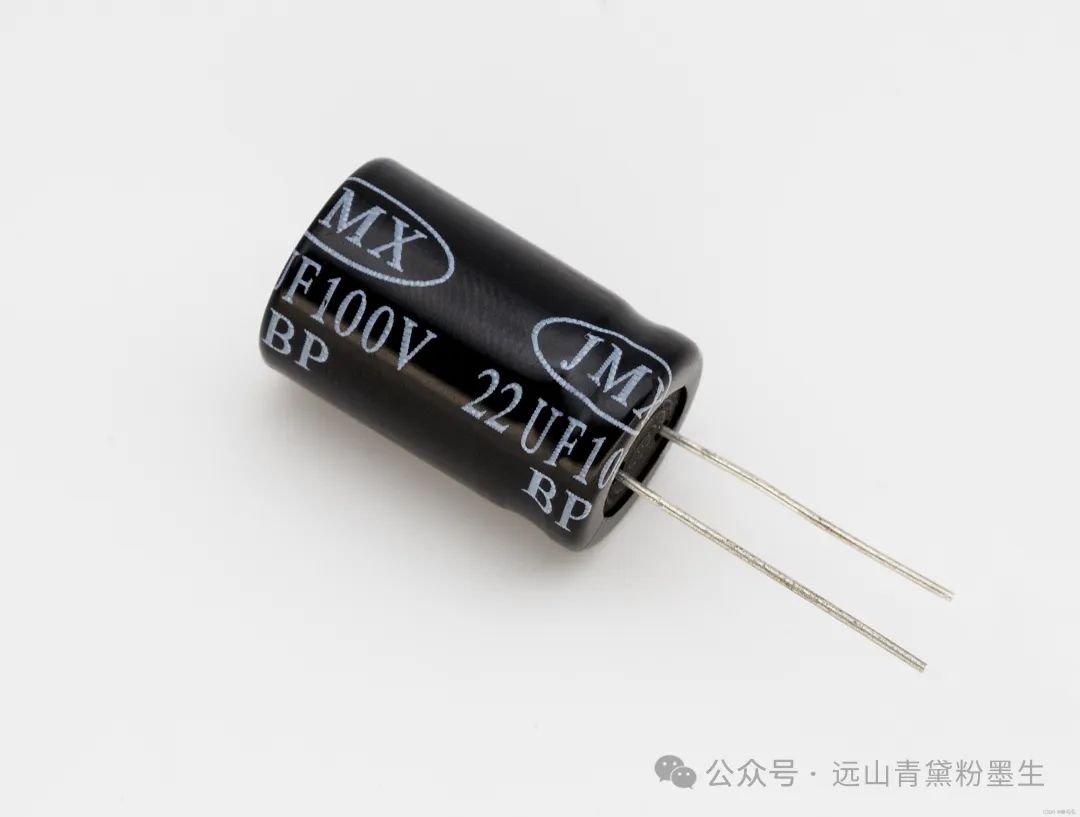In a Profibus-DP network, the bus length is one of the key factors affecting system stability. As the bus length increases, signal attenuation, delay, and interference also increase, which changes the requirements for termination resistors. Today, we will discuss in detail how to correctly choose and install termination resistors for different lengths of Profibus-DP buses.
Bus Length and Communication Rate: Understanding Basic Limitations
Before discussing termination resistors, we need to clarify the relationship between bus length and communication rate in Profibus-DP:
| Baud Rate | Maximum Bus Length |
|---|---|
| 9.6 kbps | 1200 meters |
| 19.2 kbps | 1200 meters |
| 93.75 kbps | 1200 meters |
| 187.5 kbps | 1000 meters |
| 500 kbps | 400 meters |
| 1.5 Mbps | 200 meters |
| 3 Mbps | 100 meters |
| 6 Mbps | 100 meters |
| 12 Mbps | 100 meters |
Key Point: The bus cannot be too long during high-speed communication; this is determined by physical characteristics and cannot be overcome simply by using any “high-end” termination resistors!
Termination Resistor Handling for Short-Distance Buses (≤100 meters)
Characteristics and Challenges
- Signal attenuation is relatively small
- Electromagnetic interference has a relatively small impact
- Reflection wave effects are short-lived
Termination Resistor Selection
In short-distance applications, standard termination resistors are usually sufficient:
- Integrated termination resistors in standard 9-pin D-Sub connectors (220Ω + 2×390Ω)
- Simple built-in DIP switch type termination resistors
Installation Points
- Ensure that termination resistors are enabled only at physical endpoints
- Connectors should be tightened to avoid looseness
- Short buses also require good grounding
Practical Tip: Even for short-distance buses, do not neglect the grounding of the shielding layer. I once encountered communication issues in a system that was only 20 meters long, and it turned out to be caused by the shielding layer being left floating. Remember: short does not mean simple; none of the basic principles can be overlooked!
Termination Resistor Handling for Medium-Distance Buses (100-400 meters)
Characteristics and Challenges
- Signal starts to show significant attenuation
- Bus impedance changes are more sensitive
- May be affected by external interference
Termination Resistor Selection
For medium distances, more reliable options should be considered:
- High-quality brand D-Sub integrated termination resistors (e.g., Siemens 6ES7 972-0BA52-0XA0)
- Termination resistors with indicator lights (for easier diagnosis of bus status)
- Independent termination resistor modules (e.g., Siemens 6ES7 972-0DA00-0AA0)
 Installation Points
Installation Points
- Use high-quality connectors, fixed with screws rather than quick connectors
- Pay attention to the continuity of the shielding layer; each connection must be reliably connected
- Standard termination resistor configurations are usually sufficient, but choose high-quality products
- Consider using active termination resistors when baud rates > 500 kbps
Practical Advice: For medium-distance buses, it is recommended to use separate termination resistor modules rather than connector-integrated types. As the distance increases, signal quality becomes more important, and the resistance parameters of independent modules are more stable and less affected by vibration.
Termination Resistor Handling for Long-Distance Buses (400-1200 meters)
Characteristics and Challenges
- Significant signal attenuation
- Highly sensitive to cable quality
- Cumulative effects of electromagnetic interference are evident
- Reflection wave effects are greater
Termination Resistor Selection
Long-distance applications require special considerations:
- Active termination resistors (with independent power supply to ensure stable bias voltage)
- High-precision termination resistors (tolerance ≤ 1% to ensure accurate matching with cable impedance)
- Temperature-stable termination resistors (especially important for outdoor applications)
 Installation Points
Installation Points
-
In long-distance buses, it is essential to use repeaters to segment
- Each segment length should comply with the maximum length limit for the corresponding baud rate
- Each electrical segment requires independent termination resistors
Termination resistor position diagram (long-distance bus using repeaters)
Master Station (TR on) ── Slave 1 ── Repeater (TR on|TR on) ── Slave 2 ── Repeater (TR on|TR on) ── Slave 3 (TR on)Note: TR = Termination Resistor
Active termination resistor connection diagram
Signal B ──────┬────── 390Ω ──────┐
│ │
│ │
220Ω │ Stable
│ │ +5V Power
│ │
Signal A ──────┴────── 390Ω ──────┘
│
│
↓
GNDParticular attention to the importance of bias resistors
- In long-distance transmission, cable resistance can cause voltage drop
- Ensure that both ends of the bus have the correct bias resistors to maintain signal levels
Field Experience: In a mining project, the bus length was about 800 meters, divided into 4 segments, each using active termination resistors and repeaters. Initially, when using standard termination resistors, the system frequently experienced communication interruptions during rainy days. After switching to active termination resistors with independent power supplies, the system’s stability significantly improved, even functioning normally in adverse weather.
Handling Termination Resistors in Special Scenarios
1. High Electromagnetic Interference Environments
In environments with strong electromagnetic interference, such as steel mills and electrolysis workshops:
Recommended Termination Resistors:
- Special termination resistors with filtering functions
- Opto-isolated repeaters combined with standard termination resistors

Installation Points:
- Use metal shielded conduits for wiring
- Termination resistors should be installed inside shielded boxes
- Consider using fiber optics instead of copper cables for bus segments
Case Sharing: In an electrolytic aluminum plant, even short buses frequently experienced communication issues. The final solution was to use special termination resistors with EMC filtering functions and to change critical areas to fiber optic connections. Sometimes standard termination resistors are indeed insufficient in special environments.
2. Outdoor or Temperature-Fluctuating Environments
In outdoor or temperature-variable locations, the temperature stability of termination resistors is crucial:
Recommended Termination Resistors:
- Military-grade temperature-stable termination resistors (operating range -40℃ to +85℃)
- Sealed waterproof termination resistor modules
Installation Points:
- Use UV-resistant and waterproof bus cables
- Termination resistors should be installed inside waterproof junction boxes
- Regularly check the sealing of junction boxes
Notes: Ordinary termination resistors may have a resistance change of 10-15% at extreme temperatures, which is enough to cause communication issues. In outdoor applications, always choose industrial-grade or military-grade temperature-stable termination resistors.
3. Testing Environments with Frequent Plugging and Unplugging
In testing platforms or situations where network configurations need to change frequently:
Recommended Termination Resistors:
- Programmable automatic termination resistors (can be controlled via bus commands)
- Diagnostic termination resistors with status indicators
Installation Points:
- Use reinforced connectors
- Consider installing permanent termination resistors in fixed locations
- Use termination resistor testing tools for regular verification
Technical Advice: In testing environments, it is recommended to use termination resistors with LED indicators, which can intuitively show the bus status and the working state of the termination resistors, greatly improving debugging efficiency.
Recommendations for Choosing Termination Resistors from Different Manufacturers
There are differences in performance and reliability among termination resistors from different manufacturers:
1. Siemens

- Advantages: Perfect compatibility with Siemens PLCs, stable quality
- Disadvantages: Relatively high price
- Applicable Scenarios: Important production systems, long-term running applications
2. Phoenix Contact

- Advantages: Easy wiring, strong diagnostic functions
- Disadvantages: Some models need to be cautious about compatibility with certain frequency converters
- Applicable Scenarios: Systems requiring frequent maintenance
3. IDEC

- Advantages: Cost-effective, basic functions are complete
- Disadvantages: Stability is slightly worse in high-interference environments
- Applicable Scenarios: General industrial environments, budget-limited projects
4. Wago
- Advantages: Spring clamp wiring is firm and vibration-resistant
- Disadvantages: Requires special tools for operation
- Applicable Scenarios: Applications with vibration or moving devices
Selection Principle: Choose suitable termination resistor brands and models based on bus length and environmental complexity. Key systems should prioritize well-known brands rather than seeking the lowest cost.
Practical Skills: Verification Methods After Installing Termination Resistors
Method 1: Accurate Resistance Measurement Method (Applicable to All Length Buses)
- Disconnect the power supply of all devices on the bus
- Use a high-precision multimeter (4.5 digits or more) to measure the resistance between lines A and B
- On long buses, the measured value should be close to but slightly lower than 110Ω (two 220Ω in parallel)
- If the reading is significantly low, there may be extra termination resistors enabled
- If the reading is significantly high, the termination resistors may not be connected correctly
Method 2: Signal Quality Analysis (Applicable to Medium and Long-Distance Buses)
- Use a Profibus analyzer (such as Profitrace) connected to the bus
- Observe the signal quality indicators; under normal conditions, it should be ≥90%
- Observe the eye diagram pattern; it should be clear and open, with no significant crossings
Method 3: Termination Resistor Voltage Testing (Applicable to Long-Distance Buses)
- Bus idle state (no communication)
- Measure the voltage difference between lines A and B; it should remain above 1.0V
- Measure at both ends of the bus; if there is a significant difference, it indicates high cable loss or abnormal termination resistors
Special Reminder for Long Buses: For long-distance buses, it is strongly recommended to use a professional Profibus analyzer for comprehensive testing; signal quality issues that cannot be seen with the naked eye may cause system failures under high load.
Common Problems and Solutions for Long-Distance Buses
Problem 1: Communication is normal at both ends of the bus, but intermittent communication interruptions occur in the middle devices
Cause Analysis: Signal attenuation is severe during long-distance transmission, and the middle devices receive insufficient signal strength. Solution:
- Increase repeater segmentation to ensure each segment does not exceed the applicable length
- Check the bus impedance and termination resistor matching
- Use signal amplifying repeaters
Problem 2: Communication instability due to temperature changes
Cause Analysis: Ordinary termination resistors have a large temperature coefficient, and outdoor temperature differences cause resistance changes. Solution:
- Replace with temperature-stable termination resistors (temperature coefficient < 50ppm/℃)
- Install termination resistors in relatively stable temperature environments
- Consider using automatic adjustment termination resistors
Problem 3: Communication quality decreases in rainy or humid environments
Cause Analysis: Moisture intrusion leads to impedance changes or short circuits. Solution:
- Use sealed termination resistors and connectors
- Seal junctions with waterproof glue or heat shrink tubing
- Regularly check the sealing of junction boxes
Practical Case: In a control system for a conveyor belt about 1000 meters long, the original segmented approach (3 repeaters, 4 bus segments) still had stability issues. After testing, it was found that due to uneven impedance during long-distance transmission, the standard 220Ω termination resistors were not the best match. By measuring the actual cable impedance with professional tools, a custom 180Ω termination resistor was made, significantly improving system stability. This tells us that sometimes “customization” of termination resistors is necessary for ultra-long-distance applications.
Advanced Long-Distance Solutions
For extremely long-distance applications exceeding the recommended length, in addition to the correct termination resistors, the following technologies can also be considered:
1. Fiber Optic Repeater Technology
Using fiber optic converters instead of copper cables can achieve lossless transmission over several kilometers or even tens of kilometers.
Working Principle:
PLC ── Termination Resistor ── Fiber Optic Converter ═══ Fiber Optic ═══ Fiber Optic Converter ── Termination Resistor ── Remote DeviceKey Points: Each segment of RS-485 copper cable requires termination resistors at both ends; fiber optic segments do not require termination resistors.
2. Dedicated Long-Distance Drivers
Some special RS-485 drivers can support longer distances by increasing output power and signal processing capabilities.
Usage Conditions:
- Requires special termination resistor matching
- Usually requires separate power supply
- Baud rate is usually limited
3. Wireless Bridging Technology
In extreme cases, consider using Profibus wireless bridges to cross obstacles or extremely long distances wirelessly.
Working Principle:
PLC ── Termination Resistor ── Wireless Bridge Transmitter ~~~ Wireless Signal ~~~ Wireless Bridge Receiver ── Termination Resistor ── Remote DeviceNotes: Each wired segment still requires proper installation of termination resistors.
Practical Experiment Recommendations
To gain a deeper understanding of the impact of termination resistors at different bus lengths, you can try the following experiments:
- Set up a basic Profibus-DP network (1 master + 2 slaves) and test communication using standard termination resistors
- Gradually extend the cable (using a cable reel) and observe changes in signal quality at different lengths
- Compare the performance differences of different types of termination resistors at the same length
- Try introducing artificial interference (such as parallel power lines) in long cables and observe the anti-interference capabilities of different termination resistors
- Use an oscilloscope or professional analyzer to record waveforms and establish a reference database
Comparison Table: Impact of Termination Resistors at Different Bus Lengths
| Bus Length | Recommended Termination Resistor Type | Common Fault Phenomena | Preventive Measures |
|---|---|---|---|
| <100 meters | Standard Integrated | Intermittent faults caused by poor contact | Ensure connectors are tightened |
| 100-400 meters | High-Quality Independent Module | Occasional errors due to interference | Good shielding and grounding |
| >400 meters | Active/Custom Resistance | Signal attenuation, temperature effects | Segmentation, dedicated termination resistors |
As the length of the Profibus-DP bus increases, the selection and installation of termination resistors become increasingly critical. Short distances can use standard termination resistors, medium distances require high-quality termination resistors, while long distances need active termination resistors or even customized solutions. Remember, in long-distance applications, correct segmentation and independent termination resistor handling for each segment are the foundation for ensuring reliable communication.
Finally, no matter how long the bus is, always remember the basic principles: only install termination resistors at physical endpoints, ensure matching bus impedance, and maintain good grounding and shielding. By following these principles, even complex long-distance buses can achieve stable and reliable communication.